| |
|
|
| |
|
| Travel Tips
|
Kathmandu : Flying in from
the east (Bangkok, Singapore, Hong Kong), select seats on
the right for a view of the Himalaya. If can't see the mountain
well we can arrange flights over Everest if you want, you
can add any day of your trip.
If you are getting visa upon arrival make USD 30 cash ( for
2 months visa, subject to change with out notice) and 2 photos
handy upon arrival.
Pilgrim’s Books house in the Thamel district has a great
selection of books about Asia and Nepal.
You can buy or Hire good trekking clothings in Kathmandu if
you want to travel light.
On The Trail : One of the best
ways to physically prepare for a trek is to climb stairs before
you leave home.
Avoid bringing new hiking boots unless you have time to break
them in beforehand.
Pace yourself. Slowing down to between one-half and two-thirds
your normal hiking speed will allow you to cover long distances
without becoming overtired, don't run it is not the competetive
marathan and it is not live telecasting any where!!
Don’t bring cotton clothing for the trail. Fabrics made
of synthetic fibers that wick perspiration away from your
body are best.
Drink only purified water, and always wash your hands before
eating. Bring antibacterial hand cleaner—soap and water
are not always available.
Trekking Gently: Bring a plastic
container that can be filled with boiling water and carried
with you.
Water must be boiled or treated with iodine before it is safe
to drink.
Avoid purchasing water in nonbiodegradable plastic bottles.
Bring longer-lasting lithium batteries and take them home
with you.
Remove unnecessary packaging before leaving home and store
items in reusable containers.
Choose a reputable trekking agency for your holiday and ask
about their conservation practices.
Cultural Considerations: Revealing
clothes are not acceptable for women, and men are advised
to wear a shirt always if possible.
Pass religious sites and prayer flags on the left.
When you sit, avoid pointing your feet at any sacred objects
or at another person. Feet are considered unclean.
Do not pat anyone on the head, not even children. It is considered
the spiritual apex of the body and therefore sacred.
Photography : Always ask permission
to take someone’s photograph.
Do not promise to send photographs unless you intend to follow
through.
When in doubt about taking a picture, ask yourself if it would
be appropriate in the same circumstances at home.
In Nepalese airports carry your film with you and ask that
it be inspected by hand. Despite what you may be told, not
all x-ray equipment there is safe for film.
Lighting conditions in Nepal are extreme. For best results,
shoot in the early morning or late in the day. |
|
|
|
|
Nepal Lodge Treks - Tea House Trekking
package in Nepal |
What is Trekking?
Tea house ( lodge) in Nepal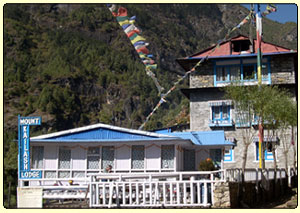
In Nepal on the more popular treks (Annapurna, Everest,
Langtang and Helambu areas of Nepal) enterprising villagers
have built tea-house lodges ( as seen in the picture). In
recent years particularly, the standards of food and accommodation
have improved enormously. Many would vie in character and
comfort with the equivalent European alpine huts. Most now
provide twin-bedded rooms. We offer a selection of tea house
treks run to a high level of service, using the good lodges
available. On trek you are guided by an English-speaking
Sherpa guide, assisted by Sherpa staff. All main baggage
is carried by porters, yaks or horses.
If you want you can buy or hire good sleeping bags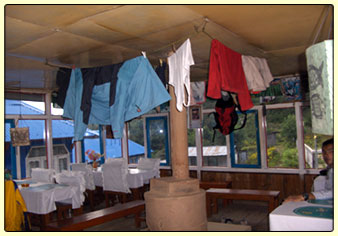 and Down jackets for those cold nights at high lodges in
Nepal. On all our tea-house treks package all meals are
included in trek. We further cover the costs of four hot
showers on trek. National Park fees are covered and in the
cities, good quality hotels ( 3 star) are provided. All
airport / hotel transfers are included, internal flights
are part of the package and transport to and from roadheads.
By using the lodges you will have the closest possible contact
with the Nepalese people.
and Down jackets for those cold nights at high lodges in
Nepal. On all our tea-house treks package all meals are
included in trek. We further cover the costs of four hot
showers on trek. National Park fees are covered and in the
cities, good quality hotels ( 3 star) are provided. All
airport / hotel transfers are included, internal flights
are part of the package and transport to and from roadheads.
By using the lodges you will have the closest possible contact
with the Nepalese people.
Trek Nepal's famous trails with friendly Sherpa guides and
stay in comfortable family run lodges (tea houses). Enjoy
ethnic Himalayan cultures and great mountain views. We have
guided lodge treks to Everest base camp, Annapurna Circuit,
Annapurna base camp, and Langtang area. Home stay treks
are also available with us.
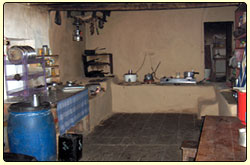 A
DAY ON TREK ( sample day) A
DAY ON TREK ( sample day)
Our Lodge - to - lodge Treks are led by one of our experienced
cheerful local guides supported by porters to carry luggage
and equipment who are very dedicated and proud to their
job. All our guides have undergone the trekking guide training
conducted by the Department of Tourism of Nepal and are
registered and licensed by the government. Additionally
all our guides go through a rigorous training to make them
better qualified to take care of our guest in every way
possible.
A trek-day starts around 7 a.m. with a cup of tea or coffee.
After packing your duffel and day-pack a breakfast of porridge
/ muesli / cornflakes and biscuits with tea / coffee is
served. The day's trek starts around 8 a.m. Porter carry
all luggage and equipment. All you need to carry in your
day-pack are water bottle, rain / wind jacket, camera and
other small items you may need on the trail. All trekkers
walk at their own pace accompanied by the trek guide. With
larger groups there is a "lead" and "sweep"
sherpa providing support throughout.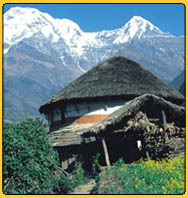
The morning's walk to the lunch spot takes about three hours.
Around mid-day we usually stop for a simple hot lunch at
one of the way side tea-houses ( you can rest , read some
books or write your diary). After hiking for three to four
hours in the afternoon we usually reached to our lodge between
3-4 p.m. In the late afternoon and evening you can relax,
wash, read or take a walk nearby. The evening meal is served
between 6 and 7 p.m. in the dining room attached to the
lodge. After dinner the guide will brief trekkers on the
next day's hike.
Each day's hike is planned so that trekkers have time to
see, photograph and explore the countryside. Anyone who
is healthy, fit, enjoys the outdoors and hiking will qualify
to participate in our treks. Not all trekking are are difficult.
Camping trek
in Nepal ( tented)
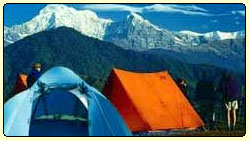 If you choose to trek in remote part of Nepal, Tibet, Bhutan
or India we provide fully supported camping trek. We provide
twin share dome or A frame sleeping tents, a mess tent,
toilet tent and kitchen tent. If you want a tent to yourself
you can pay a small single tent supplement. We provide tables,
chairs / stools, a lantern / candles, thin sleeping mattresses
.These treks are staffed by a full local crew including
a headman, cook and assistants. Your main baggage is carried
by either porters, horses or mules. It is the camp crews'
job to perform all the camp work, including leaving the
sites clean. Food on trek is a mixture of Western and local
dishes and there is plenty of it, and plenty of choice.
Food are so good that even somtimes our trekker's warned
us to take our cook to their home!
If you choose to trek in remote part of Nepal, Tibet, Bhutan
or India we provide fully supported camping trek. We provide
twin share dome or A frame sleeping tents, a mess tent,
toilet tent and kitchen tent. If you want a tent to yourself
you can pay a small single tent supplement. We provide tables,
chairs / stools, a lantern / candles, thin sleeping mattresses
.These treks are staffed by a full local crew including
a headman, cook and assistants. Your main baggage is carried
by either porters, horses or mules. It is the camp crews'
job to perform all the camp work, including leaving the
sites clean. Food on trek is a mixture of Western and local
dishes and there is plenty of it, and plenty of choice.
Food are so good that even somtimes our trekker's warned
us to take our cook to their home!
Nepal home stay trek
In recent days we have developed some home stay treks in
Nepal called village tourism for sustainable tourism, to
generate the income for local people in rural area. Chitwan
Chepang Hill trails, Langtang Tamang Heritage trails, Ghale
Geoun - Ghana Pokhara trek are few to name. In this Himalayan
treks you may stay few nights with a local family or in
an alternative 'home' such as monastery with guest accommodation,
or a large family house which has been extended to provide
rooms for paying visitors. Accommodation and facilities
in these home stays tend to be very simple. Please contact
to us if you are considering a trip which includes home
stays and would like more detail.
Sleeping bag and liner
On some of our treks we provide good quality feather down
sleeping bags at no charge. If you want you can buy good
quality sleeping bag and jackets in Nepal at reasonable
price so you can travel light from home.
Our Himalayan Trek Leader
We supply one of our own highly experienced and trained
trekking guides. A trekking guide's role is to be a liaison
between the party members and the trekking crew, to handle
all the airport / hotel check-ins, and to help you with
any problems you may have. Each leader has a medical kit
and some first aid background. They are chosen for their
outgoing natures and each brings a particular skill to their
chosen trek. They too are professionally-trained and are
there to make the party go with a swing, but at the same
time they take responsible decisions for the benefit of
the group as a whole, should the occasion arise.
|
|
Who we are ( Earthbound Expeditions) ? |
We are a group of young, energetic, trained
and educated people who have gained lots of experience and
reputation in Nepal's travel trade.
Earthbound Expeditions is a fully licensed and registered
company in Nepal and recognized by the tourism authority of
the government of Nepal to run tours, travel, trekking, mountaineering
expeditions, and other travel related activities. We fulfill
all the requirements such as tax registration, bank guarantees,
licensed guides, insured staffs and we are authorized by the
National Bank of Nepal to deal with foreign currency transaction.
Needless to mention but you must be sure that the company
you are booking a trip with is a genuine company and is not
a fraud. Be careful! There are many so-called companies who
have no registration to government authorities and do not
maintain the government requisites also. Some companies have
their licenses already expired but because of poor controlling
system, they are not noticed or punished. Some individuals
and freelancers are reported to have created their personal
web sites or by personal contacts, they run tours and trekking
programs illegally or on commission basis with an agency.
Some tour operators abroad also have been found involved in
directly operating tours and trekking expeditions without
co-operation with local agents, which is principally not allowed.
These foreign operators do not pay tax to the local government.
So, booking a trip with such companies or individuals can
have a lot of risks and hassles.
So, its always
recommended that you book a trip with a travel company, which
|
- Is registered to government authorities
- Is tax-payer
- Has insured staff against accidents
- Has well-paid staff
- Ensures security of your money
- Use local manpower and resources
- Environmentally conscious and socially
responsible
Please
see our list of works where we have been supporting
___________________________________________________
What is Trekking?
Text taken from
Frommers - Nepal Travel
Guide book ( thank you for the guide book)
Trekking is simply another name for hiking. The term,
which is from Afrikaans and originally meant a journey
by ox cart across South Africa, was first applied to
hiking in Nepal in the early 1960's by retired Ghurka
Col. Jimmy Roberts. Roberts, who was the first person
to take paying clients on guided hikes in Nepal, patterned
his treks after early Nepal mountaineering expeditions.
His trips had basically everything the big expeditions
had-guides, Sherpa porters, cooks, and kitchen boys.
Clients didn't scale the peaks; but they came close
and that was what they wanted. Today, camping treks
are still done the way Col. Roberts pioneered them.
However, unlike in the early 1960s, there are now hundreds
of lodges scattered along Nepal's many miles of trails,
and trekkers have the option of hiking from lodge to
lodge either on their own or with a porter and a guide,
or even just a porter. This style of trekking is called
teahouse trekking, from the teahouses (bhattis) that
first served as lodges for adventurous trekkers (mostly
hippies) who headed off into the hills on their own
in the late 1960s and early 1970s. The original teahouses
were very simple affairs that had traditionally catered
to Nepali traders and porters. Today, there are still
such simple places along some trekking routes, but the
lodges frequented by trekkers are, for the most part,
much more elaborate, with large dining rooms, terraces,
gardens, private rooms, and sometimes even indoor plumbing.
For most first-time visitors, the chance to view the
Himalayas, the highest mountains on earth, is the primary
reason for trekking. Imagine hiking at elevations above
13,000 feet (almost as high as the highest mountains
in North America) and gazing up at mountain peaks that
are another 13,000 feet higher. This is a powerful draw.
Although trekking is basically backpacking, it's quite
different from backpacking as North Americans know it.
Trekking, by and large, is not a wilderness experience
but rather a cultural experience. Nepal is an ethnic
mosaic, and a trek is not just an opportunity to gaze
at snow-covered peaks, it is a chance to observe the
lifestyles of the different peoples who have inhabited
these mountains for centuries. There are lowland Hindu
farmers of the Brahmin and Chhetri castes, proud Gurungs
whose villages have supplied the Gurkha regiments for
decades, Thakali innkeepers whose families have catered
to travelers for centuries, and high-country Sherpas
who have made a name for themselves as superior mountaineers.
Each ethnic group has its own cultural identity and
is distinguished by its clothing, farming practices,
architectural styles, and religious beliefs. Of course,
there are beautiful mountains to look at here (and there's
no denying that they are impressive), but it is the
cultural diversity that makes Nepal unique. And though
you may come for the mountains, it is the people that
are likely to leave the greatest impression on you.
This cultural diversity is in part due to Nepal's varied
landscape. From the subtropical valleys of the middle
hills to the alpine meadows of the high Himalayas to
the desert-like conditions of the trans-Himalayan regions,
Nepal boasts an amazing range of natural habitats. Humans,
plants, and animals have all evolved and adapted to
these conditions. On south-facing slopes, terraced fields
stair-step up mountainsides, allowing farmers to grow
barley, rice, wheat, and millet. In moist, shaded valleys,
bamboo forests thrive and ferns proliferate. On more-open,
cloud-swept hillsides, rhododendrons grow into trees
and color the mountains with their spring blossoms.
In the upper elevations, blue sheep and Himalayan tahrs
(a type of mountain goat) graze in alpine meadows dotted
with tiny gentians. In the rainy shadows to the north
of the Hima-layas, a barren landscape of thorny scrub
and ground-hugging plants belies the fertility of fields
watered by extensive networks of irrigation canals.
A trek of only a week can take in all of these habitats,
providing a journey through a myriad of landscapes.
This is what trekking in Nepal really means-exploring
the country's culture, geography, and wildlife amid
the highest mountains on earth.
|
For Further Information
Please Mail
Us |
|
|
|






